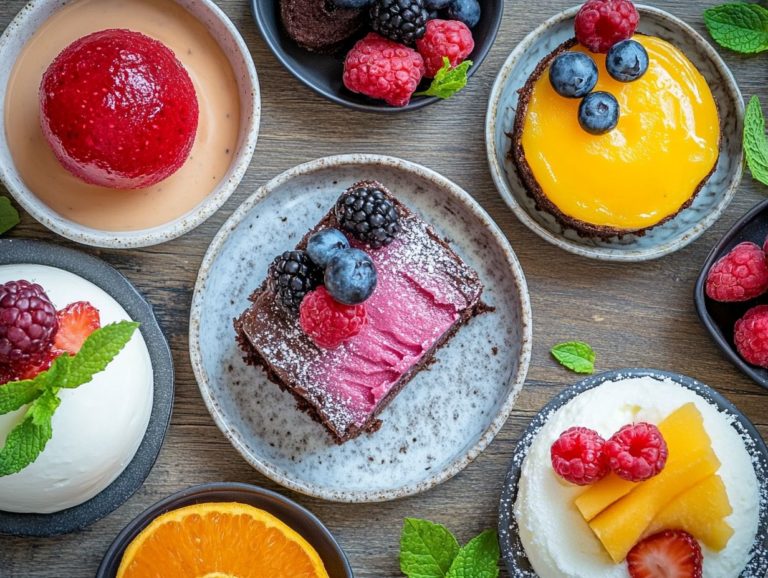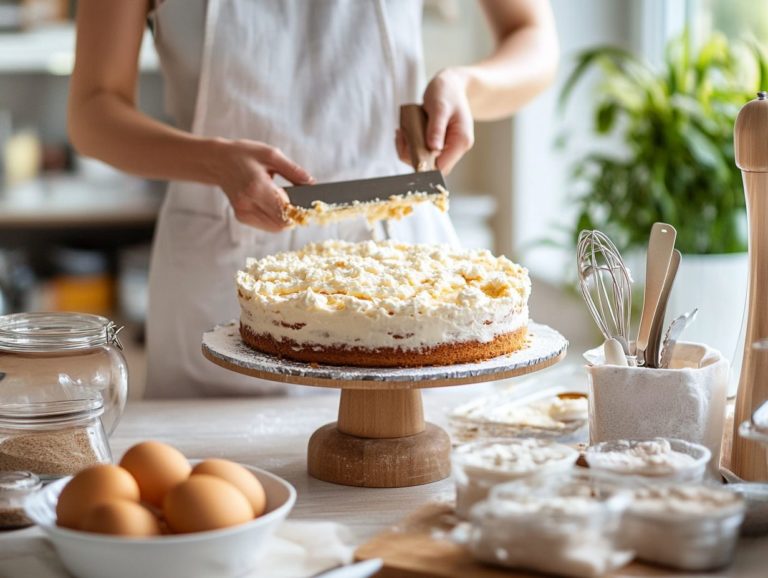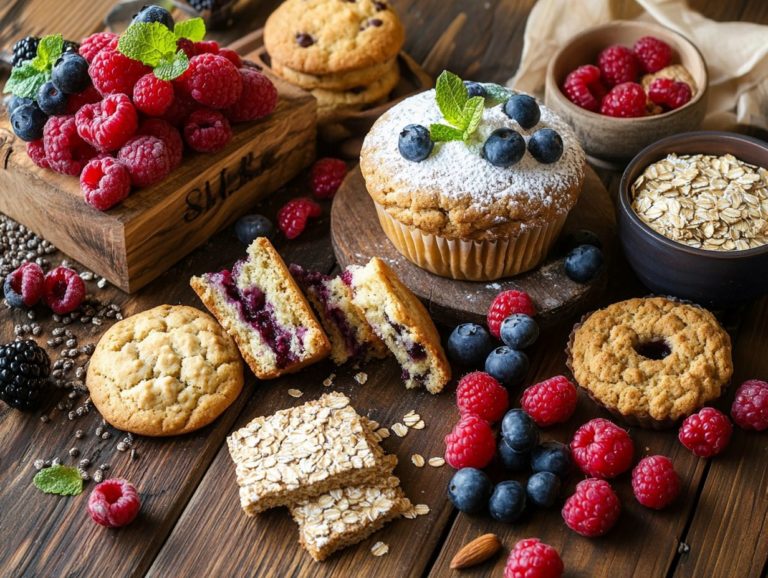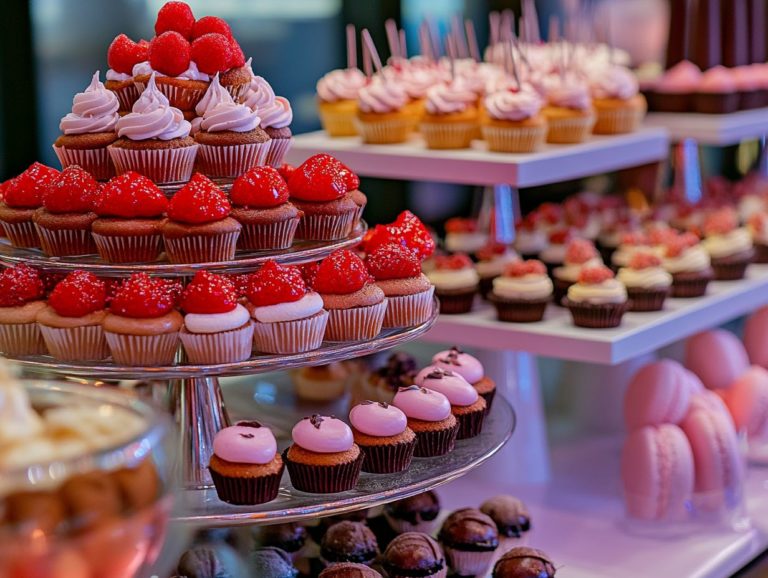How to Adjust Dessert Recipes for Altitude?
Baking at high altitude presents a delightful challenge, transforming your kitchen into a sophisticated area of flavor and texture. Embracing high-altitude baking lets you explore unique baking techniques and methods.
The thinner air and lower atmospheric pressure can play tricks on your favorite dessert recipes, potentially leading to disappointing outcomes. Adapting your sea-level recipes to high-altitude conditions can be crucial for success.
Get ready to uncover the secrets of high-altitude baking in this essential guide! From crucial adjustments for cakes and cookies to invaluable baking tips for mastering high-altitude baking, you will acquire the expertise needed to craft exquisite treats, regardless of how high you soar!
Contents
- What is Altitude?
- How Does Altitude Affect Baking?
- What Are the General Rules for Adjusting Dessert Recipes for Altitude?
- What Are the Specific Adjustments for Different Types of Desserts?
- What Are Some Tips for Successful Baking at High Altitude?
- 1. Use High Altitude-Specific Recipes
- 2. Test and Adjust Recipes
- 3. Make Small Changes
- 4. Keep an Eye on the Oven
- Frequently Asked Questions
- How do I adjust dessert recipes for high altitude?
- What are the main adjustments that need to be made for high altitude baking?
- How do I decrease the amount of leavening agents for high altitude baking?
- Why do I need to increase the liquid in my recipe for high altitude baking?
- Should I decrease the amount of sugar in my dessert recipe for high altitude baking?
- Are there any other adjustments I should make when baking at high altitudes?
Key Takeaways:
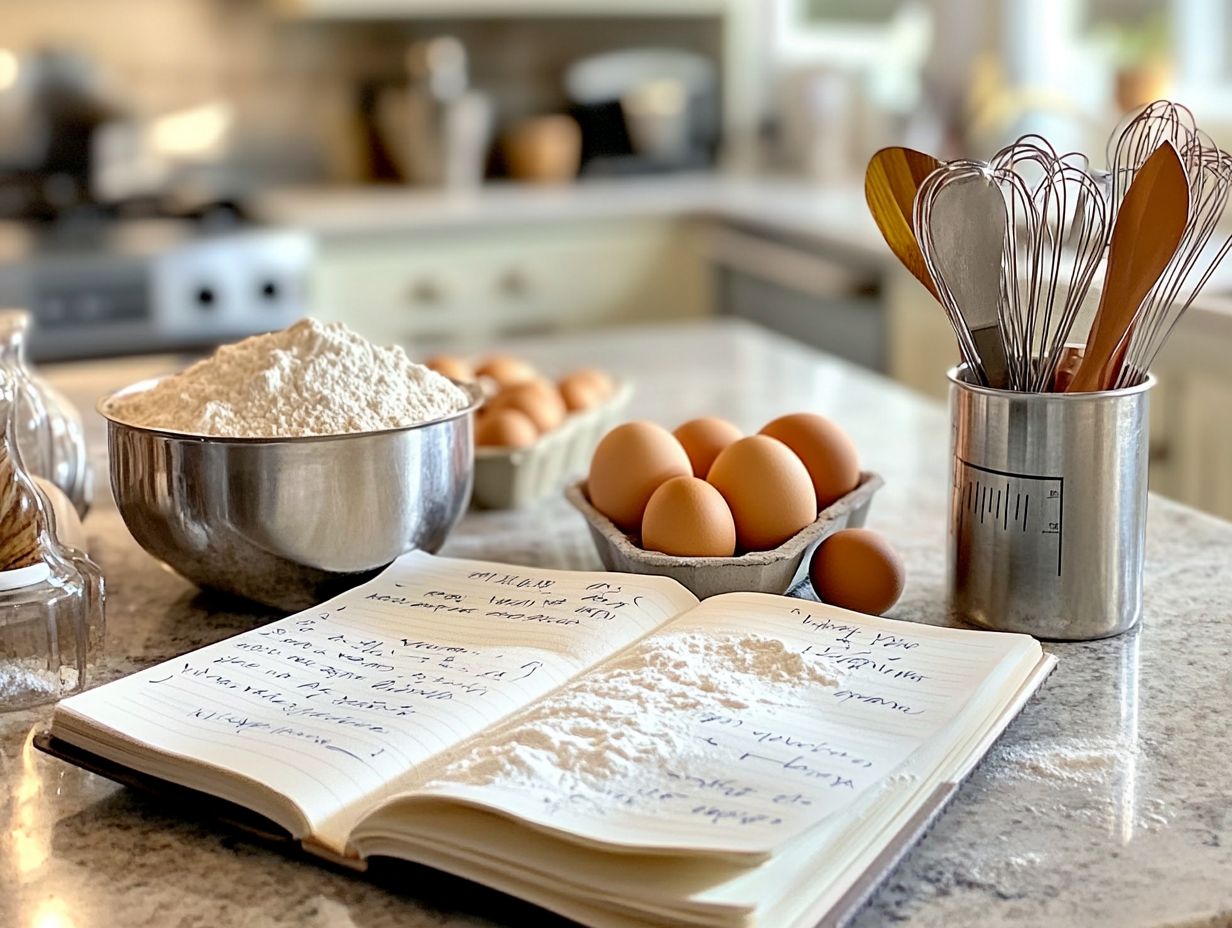
- Altitude affects baking by changing air pressure and moisture levels, leading to longer baking times and changes in ingredient ratios.
- To adjust dessert recipes, increase baking time, decrease sugar, increase leavening agents, decrease oven temperature, and adjust liquid amounts.
- Tips for successful high-altitude baking include using specific recipes, testing and adjusting, making small changes, and closely monitoring the oven.
What is Altitude?
Altitude refers to how high a location stands above sea level, and it can significantly influence a range of activities, particularly high-altitude baking. In areas like Mammoth Lakes, California, and Denver, Colorado, where the elevation soars above sea level, bakers face both unique challenges and exciting opportunities. Nikki Hampton and Mimi Council, authors of The Mountain Baker and Sugar High, provide valuable insights on these adjustments.
Grasping the nuances of altitude is essential for you to ensure that your baked goods attain the perfect texture, flavor, and structural integrity.
How Does Altitude Affect Baking?
Altitude significantly influences baking, as the reduced atmospheric pressure at higher elevations affects how your baked goods rise and retain moisture. When you re baking at high altitudes, it s crucial to adjust your ingredients and processes to tackle challenges such as moisture evaporation, which can result in dry and disappointing outcomes.
By grasping these factors, you can ensure that your cakes rise perfectly and your cookies achieve the ideal texture. This understanding will help you enjoy overall success in your baking endeavors.
Why Do Dessert Recipes Need to Be Adjusted for Altitude?
In terms of dessert recipes, you’ll find that adjustments for altitude are essential, given the unique challenges high-elevation environments present. These challenges can significantly impact both the structural integrity and flavor development of your creations. Ingredients like flour, sugar, and leavening agents behave quite differently at higher altitudes. You ll need to make specific adjustments to ensure that your cakes, cookies, and muffins turn out just right.
Without these modifications, you may end up facing issues like cake fall or inconsistent texture. Expert bakers from Dessert D Organic Bake Shop in Mammoth Lakes, California recommend focusing on flour adjustments and moisture retention to combat these problems.
For example, the lower air pressure at higher elevations can cause your baked goods to rise more quickly, leading to excessive expansion and a potential collapse if not handled with care. You might find that increasing the amount of flour slightly can counteract this rapid rise, which is crucial for maintaining the overall structure of your dessert.
You should also reduce sugar to avoid overly sweet flavors, as it caramelizes more quickly in the thinner air. You also need to recalibrate your leavening agents, as they tend to react more vigorously, which can lead to a denser composition if not adjusted for the altitude.
Grasping these variations is vital for achieving perfectly baked desserts that are not only delicious but also visually stunning.
What Are the General Rules for Adjusting Dessert Recipes for Altitude?
In the realm of high-altitude baking, adhering to essential guidelines for adjusting your dessert recipes is crucial to achieving the results you desire. Key adjustments to consider include:
- Extending baking time
- Reducing sugar content
- Increasing leavening agents
- Lowering the oven temperature
- Fine-tuning liquid amounts
These modifications are instrumental in counteracting the challenges posed by higher elevations, ensuring your baked goods rise beautifully and preserve their intended texture and flavor.
1. Increase Baking Time
Increasing baking time is crucial when you’re working in high-altitude environments. The lower atmospheric pressure can lead to uneven cooking and slower baking than what you d experience at sea level. By allowing your baked goods, such as cakes and muffins, that extra time in the oven, you can achieve the perfect doneness without sacrificing texture or moisture.
To effectively extend your baking time, it’s important to pay close attention to visual cues. Rely on trustworthy testing methods. For instance, you ll want the tops of your cakes to reach a lovely golden-brown color. A skewer inserted into the center should come out clean or with just a few moist crumbs. Watch how your batter rises and how it separates from the edges of the pan these signs can provide valuable insights into doneness.
By implementing these techniques and being mindful of high-altitude adjustments like reducing sugar or increasing flour you’ll ensure that your baked goods turn out both delicious and perfectly cooked, no matter where you re baking.
2. Decrease Sugar
Decreasing sugar in high-altitude baking is essential because sugar can affect the structure and moisture retention of your baked goods. At higher elevations, the sweetness tends to become more pronounced, so adjusting the sugar levels is key to maintaining a balanced flavor while ensuring that your cakes and cookies have the right texture.
This adjustment elevates the taste and plays a significant role in achieving the desired crumb and rise of your creations. For example, when baking cakes, reducing sugar by about 1 to 2 tablespoons per cup can yield a more harmonious flavor without sacrificing sweetness.
For cookies, cutting back by 1/4 cup of sugar for every cup used can keep them from becoming overly sweet while preserving that delightful chewy texture. Such reductions lead to desserts that are not only healthier but also allow other flavors, like vanilla or chocolate, to take center stage and shine more prominently.
This technique is particularly useful for chocolate chip cookies and almond-scented cake, enhancing their robust flavors.
3. Increase Leavening Agents
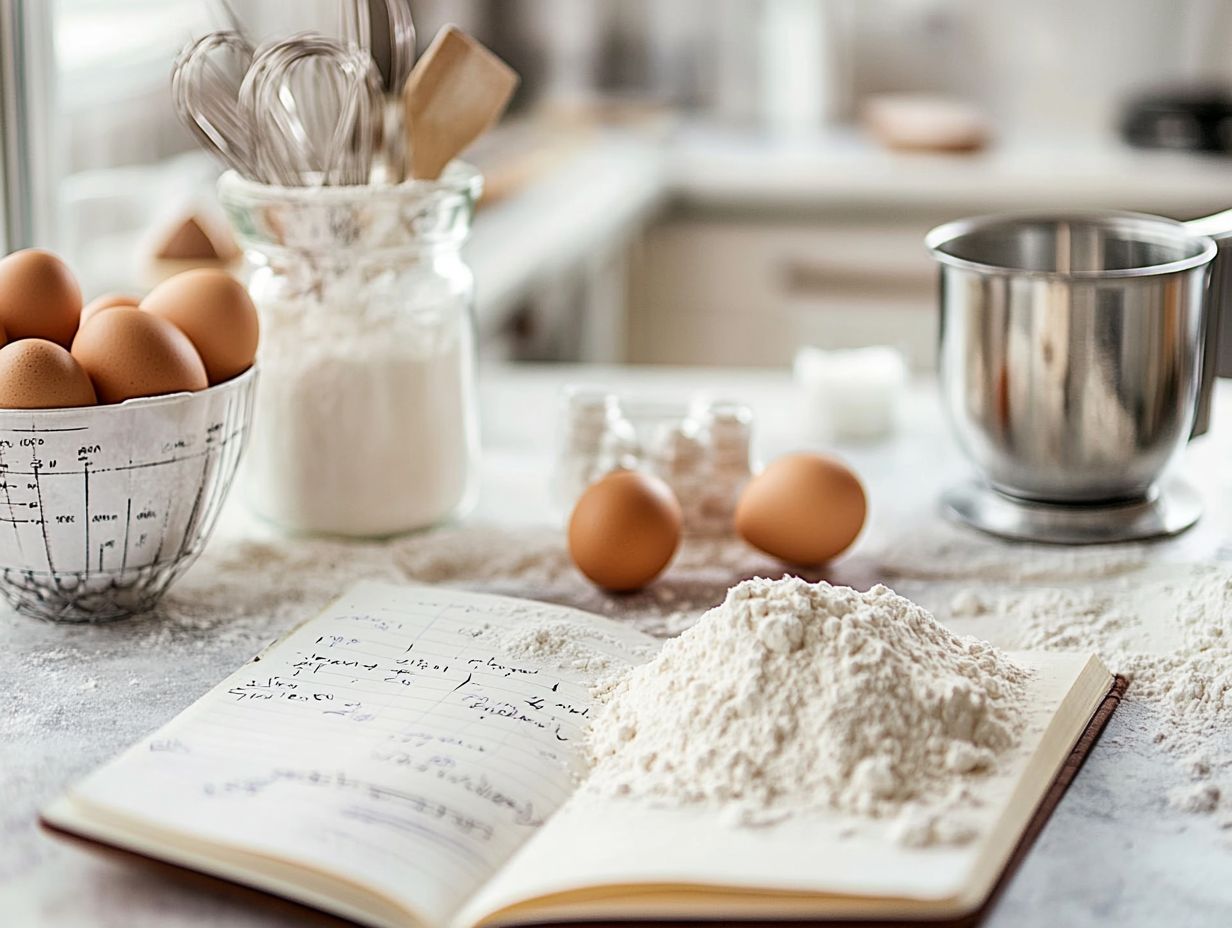
When you re baking at high altitudes, it s essential to increase your leavening agents like baking powder and baking soda. The reduced air pressure can diminish their effectiveness, so adding a bit more helps your baked goods rise properly. This adjustment is a game changer for achieving that desired fluffiness in your cakes and muffins.
As you determine the right amount of leavening agents, consider the specific elevation where you ll be baking. A good rule of thumb is to increase the amount of baking powder by about 1/4 teaspoon for every 1,000 feet above sea level per cup of flour.
For instance, in the stunning heights of Colorado, where altitudes often exceed 5,000 feet, making these careful adjustments for recipes like brownies and bread rolls becomes vital. You can turn to successful high-altitude recipes, such as those for angel food cake, as a valuable reference. They illustrate how these small tweaks can enhance texture and rise without sacrificing flavor.
Start experimenting with these tips today for bakery-quality results at home!
Key Adjustments for Baking at High Altitude
4. Decrease Oven Temperature
Decreasing the oven temperature is essential when you’re baking at high altitudes. It helps prevent your baked goods from rising too rapidly, which can lead to collapse. A cooler oven allows for a more gradual rise, ensuring a stable structure and avoiding issues like cake fall or cookie spread that often occur at higher elevations.
This baking temperature adjustment is among the key baking guidelines for high-altitude kitchens. In these challenging conditions, adjusting the baking temperature not only enhances the final product but also compensates for the lower air pressure you face.
For recipes such as muffins or quick breads, a reduction of about 25 F is typically recommended, and cakes will benefit from a similar adjustment. Watch your baking time closely, as it may lengthen with the cooler temperature.
By maintaining precise control over your oven settings, you create a more consistent baking process, particularly for delicate items like souffl s, which are especially sensitive to temperature fluctuations at altitude.
5. Adjust Liquid Amounts
Adjusting liquid amounts in high-altitude baking is crucial because more moisture evaporates at higher elevations. Adding more liquid can ensure your cake batters and cookie doughs maintain the right consistency and moisture level, leading to delightful outcomes.
Consider using high-moisture ingredients to counteract the effects of altitude on your baked goods. To determine the right adjustments, consider the type of recipe you’re working with.
For example, when crafting a sponge cake, increasing the liquid by an additional 1-2 tablespoons per cup can help combat dryness while preserving that light, airy texture you desire. Similarly, for bread recipes, incorporating extra water or milk can boost dough hydration and facilitate better gluten development.
Don’t hesitate to experiment with ingredients that naturally retain moisture, like yogurt or applesauce. These not only enhance flavor but also contribute to a desirable level of moisture retention. Ultimately, adjusting liquid amounts based on elevation and the specific requirements of your recipes ensures you achieve the perfect balance for your culinary creations.
What Are the Specific Adjustments for Different Types of Desserts?
In terms of high-altitude baking, each type of dessert demands its own unique adjustments. Cakes, cookies, pies, quick breads, and yeasted breads react differently to the elevation, so it s crucial to grasp these nuances.
Understanding these variations is the key to achieving the perfect texture, flavor, and appearance for every dessert. Make the right adjustments to ensure your desserts shine at high altitudes!
1. Cakes
When you’re baking cakes at high altitude, making specific adjustments becomes essential to ensure they rise beautifully and maintain their structure. You ll want to increase your leavening agents, decrease the sugar, and tweak your baking time in pursuit of deliciously light and fluffy cakes that won t collapse under pressure.
These modifications are crucial because lower air pressure can dramatically affect how your cakes behave in the oven. For example, when whipping up a classic vanilla sponge, consider adding an extra teaspoon of baking powder to give your cake that extra lift. Cutting back on the sugar just a bit can help prevent your cakes from becoming overly moist, which can lead to a gummy texture that no one wants.
Keep an eye on your baking time, as high-altitude cakes tend to bake more quickly. Ensure you achieve a perfectly cooked interior without the risk of a dry exterior. Understanding these adjustments can transform your high-altitude baking experience into one filled with success and delightful desserts.
2. Cookies
Baking cookies at high altitude demands careful adjustments to achieve the perfect texture and consistency. Consider increasing the flour, reducing the sugar, and tweaking the baking time to ensure your cookies bake evenly while preserving their intended flavor and structure.
To perfect classic cookie recipes like chocolate chip or oatmeal raisin, the final product often ends up dry or crumbly without these adjustments. For instance, adding an extra 1 to 2 tablespoons of flour provides stability, preventing your cookies from spreading too thin during baking.
Reducing the sugar combats excess sweetness and minimizes the risk of excessive caramelization, a common dilemma at higher elevations. Keep a close eye on the baking time; reducing it by just a few minutes helps you avoid over-baking and achieve that soft, chewy texture cookie lovers yearn for.
3. Pies and Tarts
When making pies and tarts at high altitude, adjusting your pie crust recipe is essential for achieving that flaky and tender result. Adjust the liquid amount and monitor your baking time to avoid common issues like shrinking crusts or undercooked fillings.
For instance, reduce the liquid by a tablespoon or two to maintain the structure of your crust, as dough tends to spread more easily at higher altitudes. Increase your oven temperature by about 15 to 25 degrees Fahrenheit to ensure your crust browns just right before the filling overcooks.
Successful high-altitude pie recipes often include classics like apple or pumpkin. Incorporating these techniques allows you to create beautifully balanced flavors and textures. Using a blind-baking method further enhances your results, providing a solid foundation that holds up against moist fillings without becoming soggy.
4. Quick Breads
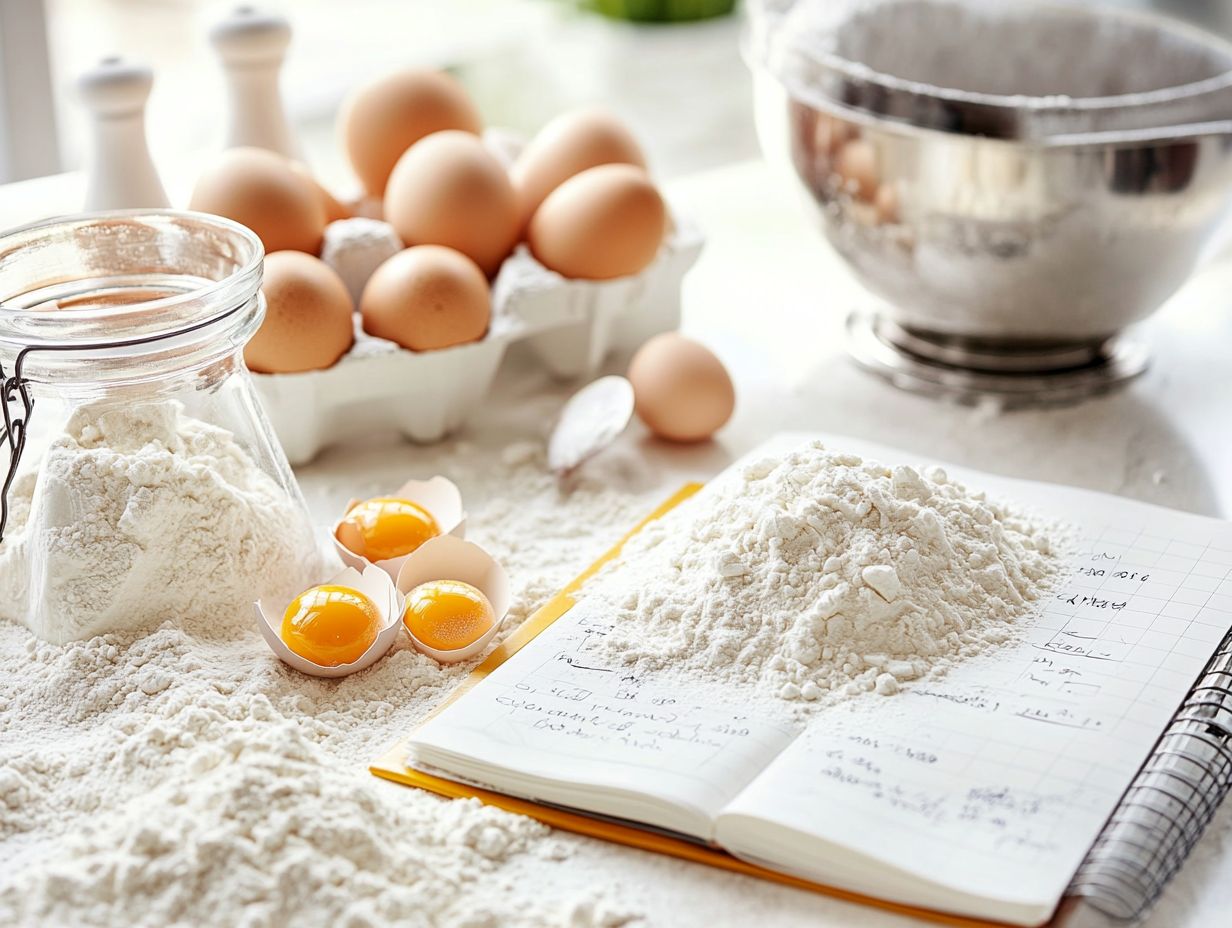
For quick breads, which rely on baking powder or baking soda instead of yeast, specific adjustments for high-altitude baking are necessary to ensure they rise beautifully and retain that moist texture you crave. Key modifications include increasing your liquid and leavening agents while reducing sugar for the right consistency.
At higher elevations, lower atmospheric pressure can cause quick breads to rise too quickly, leading to a collapsed or dry outcome. Experiment with the ratios of flour and fat in your recipe. Incorporating ingredients like yogurt or sour cream enhances moisture and richness.
Adjust your baking times; quick breads often require a shorter baking duration to prevent over-drying. By understanding and implementing these essential adjustments, you ensure your final quick bread not only tastes divine but also boasts perfect texture and rise.
5. Yeasted Breads
Baking yeasted breads at high altitude requires adjustments to ensure your dough rises properly and develops robust flavors. Changes in yeast quantity, hydration levels, and proofing times drastically influence the final product’s texture and taste.
Reduce the yeast by about 25% to avoid over-proofing, as the leavening process speeds up at higher elevations. Increase the liquid content by approximately 2-4 tablespoons per cup of flour to achieve the desired dough consistency, compensating for quicker moisture evaporation that occurs at altitude.
Shorten the first rising period, keeping a close eye on your dough until it doubles in size this may only take 30-45 minutes. After a gentle punch down and shaping, follow up with a shorter second rise, allowing the final proofing to complete without exhausting your dough.
By incorporating these adjustments, you can enjoy yeasted bread that is perfectly risen and bursting with flavor, even in challenging baking conditions.
What Are Some Tips for Successful Baking at High Altitude?
Mastering the art of baking at high altitude demands that you pay close attention to several critical factors, including tailored kitchen tips and necessary recipe adjustments.
By grasping how to tackle the unique challenges presented by high-altitude environments, you can refine your baking techniques and achieve not just consistency, but also delightful flavors across an array of baked goods.
1. Use High Altitude-Specific Recipes
Using high altitude-specific recipes is absolutely crucial for achieving baking success, as these recipes are crafted to address the unique challenges posed by altitude. By following recipes designed specifically for high-altitude baking, such as those by Nicole Hampton or Mimi Council, you can enjoy more reliable and satisfying results.
These tailored recipes take into account important factors like lower air pressure, which can cause cakes to rise too quickly and then collapse, or lead to cookies spreading excessively. For instance, if you’re adapting a classic chocolate chip cookie recipe, you might need to increase the flour a bit and reduce the leavening agents to enhance the texture.
In terms of baking bread at high altitudes, you ll often find that using less yeast and increasing hydration is beneficial, helping to keep the bread moist and flavorful. By utilizing resources like cookbooks that specialize in altitude recipes, you can confidently tackle these challenges and create delightful treats from fluffy souffl s to rich brownies that rival anything baked at lower elevations.
2. Test and Adjust Recipes
Testing and adjusting recipes is an essential practice for you as a baker in high-altitude areas, enabling you to fine-tune your baked goods for optimal flavor and texture. By experimenting with ingredient ratios and baking times, you can adapt recipes to suit your specific altitude and preferences.
This process often entails modifying elements such as flour types, leavening agents, and liquid quantities to achieve the desired consistency and rise. For example, you might find that reducing sugar helps counteract excessive browning at high altitudes, while increasing the liquid can result in a wonderfully moist cake.
Keeping a detailed baking journal becomes crucial for documenting these modifications and their outcomes, allowing you to identify the ideal adjustments over time. Through consistent observation and recording, you not only enhance the quality of your baked products but also cultivate a deeper understanding of baking science, transforming your kitchen into a hub of culinary experimentation.
3. Make Small Changes
Making small changes to your recipes can lead to remarkable improvements in your baking success at high altitude, where even the slightest adjustments can dramatically affect the final outcome. By focusing on gradual modifications, you can learn how your baked goods respond to altitude while refining your techniques over time.
For example, altering the amount of flour or adjusting baking temperatures can make a world of difference. Adding just a tablespoon of extra flour can enhance the structure of a cake that might otherwise collapse, while tweaking the oven temperature by a few degrees can ensure even baking throughout. This is especially true for cake recipes where structural strength is crucial.
Understanding how ingredients like baking soda, baking powder, and other baking ingredients behave at higher elevations will help you achieve the desired texture and flavor in your treats. These incremental adjustments not only foster a sense of mastery in your baking but also contribute to consistent quality, transforming the act of baking from a mere chore into a delightful art form that you can truly enjoy. Moreover, such precision can be particularly satisfying when dealing with high-elevation recipes.
4. Keep an Eye on the Oven
Keeping a vigilant eye on the oven is crucial for you as a baker at high altitude, where the baking process can differ dramatically from sea-level conditions. This vigilance is part of tackling common baking challenges.
By monitoring the color, texture, and aroma of your creations, you can prevent overbaking and avoid common pitfalls like cake fall. This kind of attention helps in resolving various baking problems.
To achieve impeccable results, it s essential for you to familiarize yourself with key visual indicators and essential baking tips. A golden brown hue on cakes and pastries often signifies that they are just right. Don t underestimate the power of aroma; when those mouthwatering scents start to fill your kitchen, it s usually a good indication that your baking is nearing completion. This helps develop flavor.
Regularly checking for a firm crust on your breads and a gentle jiggle in the center of custards can also be invaluable in assessing their readiness. These checks are part of mastering baking methods.
Investing in an accurate oven thermometer is a wise move since many ovens fail to display true internal temperatures. This tool is a game-changer for perfecting your baking temperature! It will help you ensure consistent and successful baking outcomes every time, contributing to your overall baking success.
Frequently Asked Questions
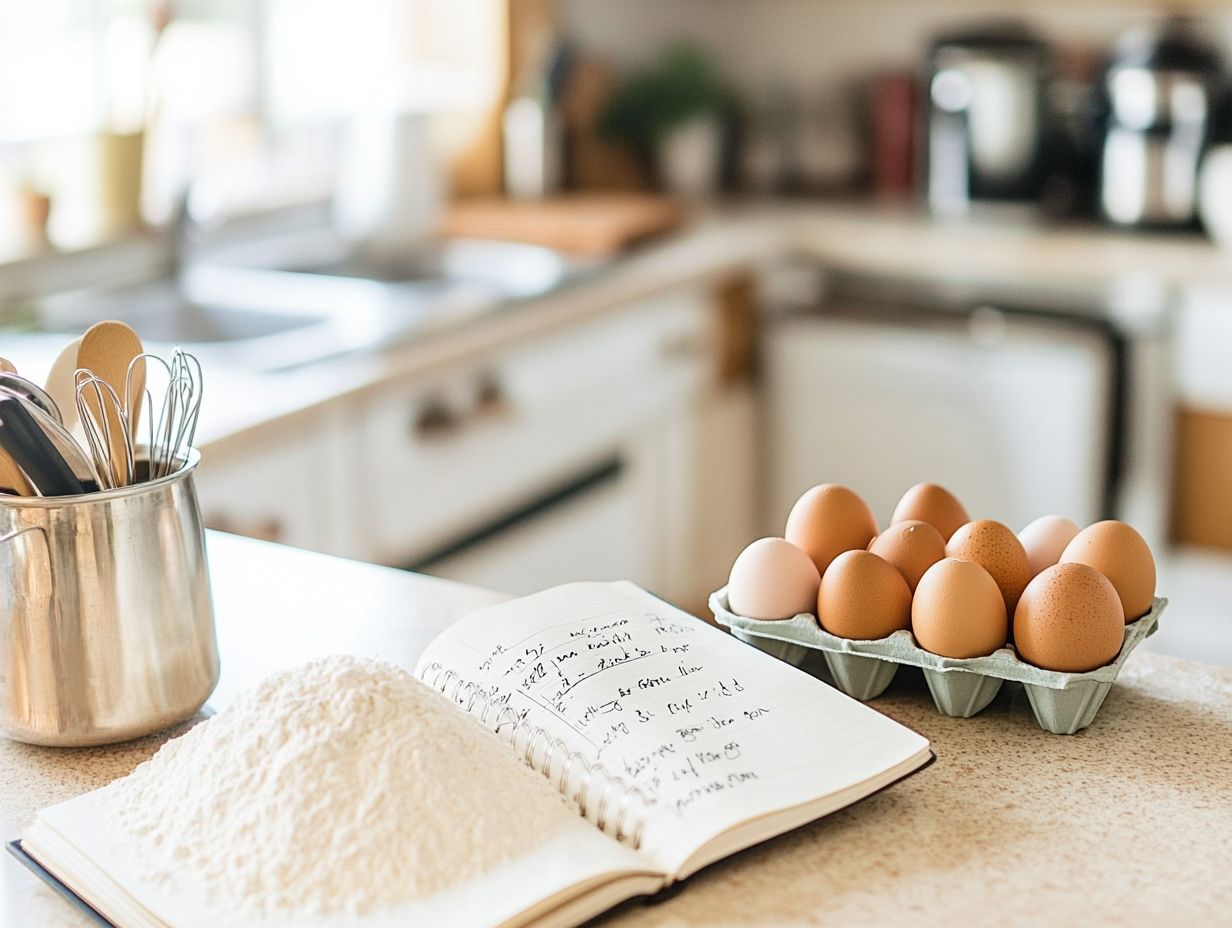
How do I adjust dessert recipes for high altitude?
When baking at high altitudes, the air pressure and moisture levels are different, which can affect the outcome of your desserts, requiring specific altitude adjustments. To adjust for this, you will need to make some changes to your recipe, often referred to as recipe adjustments.
What are the main adjustments that need to be made for high altitude baking?
The main adjustments for high altitude baking include decreasing the amount of leavening agents, increasing the liquid, and decreasing the sugar in your recipe.
How do I decrease the amount of leavening agents for high altitude baking?
At high altitudes, the air pressure is lower, which means that leavening agents like baking powder and baking soda work more quickly. This affects not only cake recipes but also cookie recipes and muffin recipes.
To counteract this, you should decrease the amount of leavening agents by about 1/8 to 1/4 teaspoon for every 1 teaspoon called for in the recipe.
Why do I need to increase the liquid in my recipe for high altitude baking?
Due to the lower air pressure at high altitudes, the moisture in your baked goods evaporates more quickly, which can result in dry and crumbly desserts, a process known as moisture evaporation. By adding more liquid, you can prevent this from happening and ensure your desserts are moist and delicious. This is crucial for high-moisture batter preparations like chocolate chip cookies.
Should I decrease the amount of sugar in my dessert recipe for high altitude baking?
Yes, decreasing the amount of sugar is important when baking at high altitudes. Sugar has a tendency to absorb moisture, and at higher altitudes, there is less moisture in the air. By decreasing the sugar, you can prevent your desserts from becoming too dry.
Are there any other adjustments I should make when baking at high altitudes?
In addition to adjusting the leavening agents, liquid, and sugar, you may also need to increase the baking temperature and decrease the baking time. These are vital baking guidelines.
It is important to keep an eye on your desserts while baking and make any necessary adjustments to ensure they turn out perfectly at high altitudes. This involves understanding baking science and the behavior of baking ingredients.
Try these tips in your next baking adventure and share your success stories!

